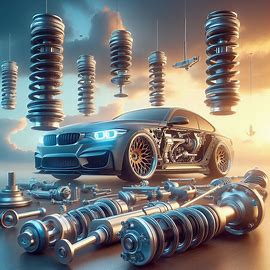
Introduction
Air Suspension vs. Coilovers — it’s a battle of comfort versus control, flair versus finesse, and flexibility versus firmness. If you’re knee-deep in a car build, this choice can define not only how your vehicle performs but how it lives on the road. Each system brings its own set of pros, cons, and quirks, and understanding them is crucial before dropping thousands on your dream suspension setup.
So, what’s best for your build? That depends. Are you chasing podiums or parking lot stares? Do you cruise daily or carve canyon roads? Let’s break it down.
Understanding Coilovers
Coilovers, a portmanteau of “coil spring over shock absorber,” are the go-to for enthusiasts seeking responsive handling and precise adjustability. This system integrates a shock absorber and a coil spring into a single unit that replaces the factory strut assembly.
Key Benefits of Coilovers:
-
Better cornering and handling due to reduced body roll.
-
Adjustable ride height and sometimes damping control.
-
Proven track performance with minimal air or electronic dependencies.
Drawbacks:
-
Can lead to a stiffer ride, which may not suit daily comfort seekers.
-
Not ideal for rough terrain or pothole-ridden streets.
Types range from basic height-adjustable models to premium fully-adjustable coilovers with rebound and compression settings. Brands like KW, Tein, and BC Racing are favorites in the enthusiast community.
Diving into Air Suspension
Air suspension systems swap the traditional coil springs for air springs — essentially rubber bellows that inflate and deflate using onboard air compressors, valves, and tanks. These setups allow for on-the-fly height adjustment, which can slam a car at shows and raise it for road clearance minutes later.
Advantages:
-
Superior ride comfort, often mimicking that “floating” feel.
-
Adjustable height at the push of a button.
-
Ideal for show builds and daily driving on poor road surfaces.
Disadvantages:
-
Expensive initial setup and long-term maintenance.
-
Complex installation and reliance on electronics.
-
Potential for air leaks or compressor failures.
Brands like Air Lift Performance and AccuAir lead the way in innovation and community support.
Cost Comparison: Air Suspension vs. Coilovers
While basic coilovers can start under $1,000, air suspension systems typically begin at $2,000–$4,000. Add compressors, controllers, and tanks, and the price climbs quickly.
| Feature | Coilovers | Air Suspension |
|---|---|---|
| Initial Cost | $800–$3,000 | $2,500–$6,000+ |
| Installation Cost | Lower | Higher |
| Maintenance | Lower, fewer components | Higher, more complex |
| Upgrade Path | Incremental | All-in-one systems |
So, if budget is a constraint, coilovers offer more value. But for that premium slam-and-raise effect? Air is king.